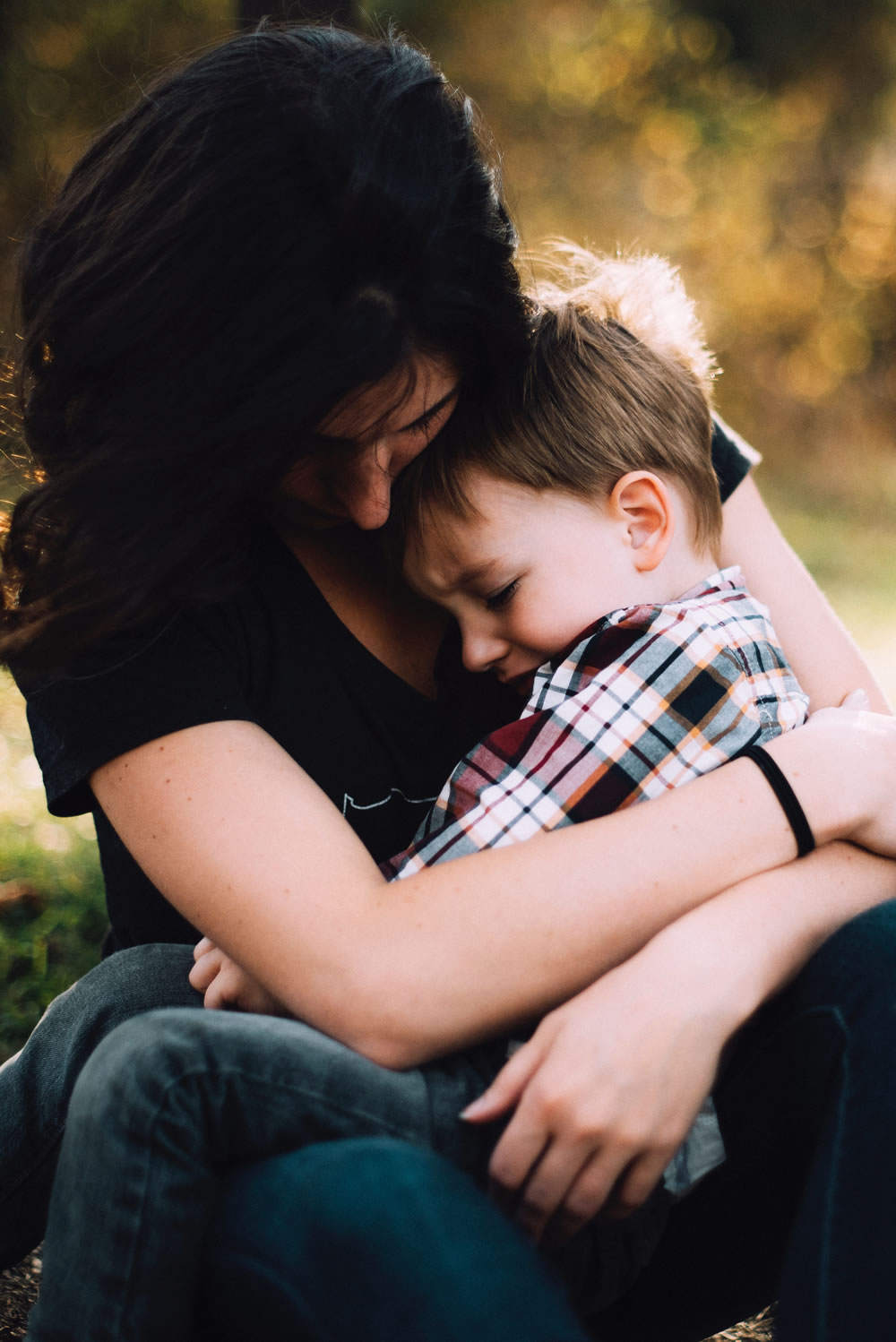
When our children get upset, most of us get upset too. If the child is angry at us, we feel defensive; like the child's feelings are unwarranted. If he's upset at something else, we want to make him feel better, to make the emotions go away as quickly as possible.
But emotions aren't dangerous. The only way to resolve emotions is to go through them, and when your child is feeling big emotions, that's an important learning opportunity. Supporting your child to learn a healthy approach to their emotions means coaching them to be aware of their feelings and to accept them. That's the first step to learning to express emotions responsibly.
Here's your game plan.
1. Calm yourself first.
- Use your pause button: Stop, drop your agenda (just for now), and take a deep breath before you engage with your child.
- Remind yourself that your goal is to calm the storm for your child, not escalate it.
- Don't take your child's emotions personally. This isn't about you, even if she's screaming “I hate you!” This is about her: her tangled-up feelings and still-developing brain.
- Calm yourself with a mantra: “It’s not an emergency” or “This is an opportunity to be there for my child when he’s upset.”
- Notice the sensations in your own body so that you're aware of what you're feeling.
- Notice if you feel annoyance, or the urge to make you child’s feelings go away. Decide that your goal is to use this opportunity to build a closer relationship with your child and teach him helpful lessons about accepting and responding to emotions.
2. Connect To Create Safety.
Your child needs to let himself feel those big emotions instead of stuffing them -- that's how they'll begin to heal. Your job is to help him feel safe, so he can let himself feel deeply.
- Reach out to connect emotionally, and if you can, physically.
- Create safety with your touch, your warmth, your tone, your attitude.
- Give your child the verbal and/or nonverbal message: “I will help you… You’re safe... You can handle this.”
- If you breathe slowly and deeply, your child will usually begin to breathe more slowly.
3. Validate and Empathize.
Your empathy creates safety by helping your child feel understood. Match your child's tone. When kids feel that you really understand how upset they are, they can let themselves feel the emotions -- and they don't need to escalate. Remember, validation doesn’t necessarily mean you agree, only that you understand why your child would feel this way.
- Welcome the emotions and reflect them, mirroring your child’s tone. “You seem a little worried about this sleepover” or “You look so mad!”
- If your child is describing a problem to you, repeat back to him what you've heard: “I hear you loud and clear. You’re fed up with your brother going into your room and taking your gum."
- If your child is expressing anger at you, resist the urge to tell her to be appropriate. Instead, acknowledge the feelings and invite her to tell you what she's upset about. “You must be so upset to talk to me that way, Amelia. We can make this better. Let's start over. I'm listening.”
- If you don't know what your child is feeling or your child gets angry when you “name” her emotions, “upset” is a good all-purpose word: “I hear how upset you are about this.”
- Describing what your child is physically expressing helps him feel seen and heard, and can either help you name emotions or intentionally avoid it: “I see you’re biting your lip. You look worried.” Or “Your arms are crossed over your chest like this, and your brows are tight, like this. I wonder what's going on?”
- Acknowledge your child's perspective. “You wish that….” or“This isn’t what you wanted….”
- If your child is crying, words can be a distraction. Use them sparingly, to create safety and welcome the emotion: “Everybody needs to cry sometimes. It's good to feel those tears and let them go. I'm right here. You're safe."
4. Double-check to be sure your child feels understood by what you've said.
This way, you don't have to worry about whether you were able to accurately reflect your child's feelings. Just ask.
- “Did I get that right?”
- “Is that what you’re telling me?”
Your child may agree—“Of course I’m mad!”—and elaborate.
Your child may correct you: “I’m not disappointed! I’m mad!” In that case, try again. If possible, use your child's exact words so they know you're listening: “I’m sorry, Caleb. I see now how mad you are. Tell me more about why.”
Or your child may correct you—“I’m NOT MAD!”—even though it's clear that you were accurate in your perception. That's a signal that your child is feeling judged or analyzed rather than understood. Acknowledge the correction and start over, connecting more as you describe the child's perspective: “I hear you, Lucas. You’re not mad. Let me see if I understand. You wanted X. Is that right?”
Don’t fight about what your child is actually feeling. What's important is that she feels that you're on her side, trying to understand. Her awareness of what she's feeling will shift as she moves through the emotions.
5. Deepen the conversation to help your child feel understood.
Your goal is for your child to feel less alone with these big feelings, which reduces the overwhelm, shame, and fear. You do this by offering support, validating your child’s emotion, and inviting your child to tell you more. This isn't just about the words you use, but about the emotional tone or resonance.
- “Ouch, that must have hurt!”
- "Oh, Sofia, no wonder you’re upset.”
- “It could be really embarrassing, to have your teacher say that.”
- “You’re saying that I love your sister more…. Ethan, that must feel so awful, to feel that…”
- “I didn’t understand how important this was to you. Tell me more.”
- “I hear how angry you are about this. What can I do to help make this better?”
- “So I hear you’re upset because of X and also Y! Is there anything else?” Asking if there's anything else often opens the floodgates to get to the heart of why your child is upset. He may start with what a lousy mother you are for making oatmeal again, and end up telling you that he thinks you love his brother more, or he’s being bullied at school.
- “Thank you for telling me this. I’m sorry that what I did upset you so much. Please tell me more.” When your child is angry at you, let him know you're listening. You may find out something that will transform your relationship for the better. Or you may find that his anger has nothing to do with you after all.
- Describe the incident without judging, so your child feels understood. “Lena wanted to play with your doll and you were worried. You said ‘No!’ You hit Lena and you both cried. Right?” Telling the story helps the child to calm down, reflect, and integrate the emotions, as the emotional experience that was processed by the right frontal lobe is articulated and understood by the verbal, more rational left frontal lobe.
Let yourself feel some of what your child is feeling, while you still stay centered. If you really feel the emotion with your child, then you may get tears in your eyes at how heartbreaking this must be for your child. This increases the connection between you and helps your child trust you.
6. Support Your Child To Problem-Solve.
Don't initiate this last step until your child is calm and ready. Most of the time, when kids (and adults) feel their emotions are understood and accepted, the feelings lose their charge and begin to dissipate. This leaves an opening for problem solving. You might say something like "This is a tough problem. I wonder what you could do now to make things better?"
Resist the urge to tell them what to do to solve the problem; that gives your child the message that you don't have confidence in their ability to handle it. If your child feels stuck, help them brainstorm and explore options.
If they suggest a solution that you think would lead to more problems, you might say: “Hmmm…. So you think you might do X. I wonder what would happen then?”
Of course, if you were part of the "problem" your child was upset about, feel free to suggest a solution: "I know it's disappointing that we can't practice your jump shot tonight because of my meeting. How about we make a deal to spend all morning on Saturday working on it?"
If your child still seems upset and negative and isn’t open to problem-solving, that’s a sign that he hasn’t worked through the emotions yet and you need to go back to the earlier steps.
Time consuming? Yes. But you'll notice that as you get more comfortable, you'll move through the steps quickly. Even better, you'll see your child get better at expressing emotions in a constructive way. Emotion coaching raises kids who are more emotionally intelligent and better at regulating their emotions. It also helps you stay calm when your child is upset, so it creates a more peaceful household.
Less drama, more solutions. And a lot more love.





